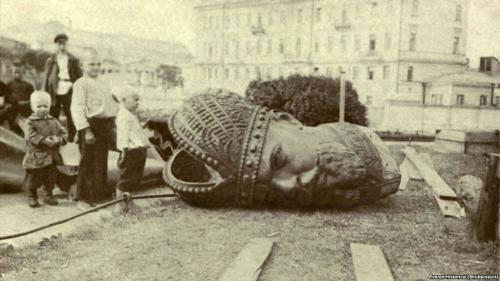
On Wednesday, November 8 the auditorium of the Whitney Humanities Center opened its doors to the public for the fifth screening in its Red Century: The Russian Revolution on Film series. This time the audience was treated with Esfir Shub’s silent film The Fall of the Romanov Dynasty (Падение династии Романовых 1927), which was commissioned by Sovkino to commemorate the tenth anniversary of the February Revolution. In her introductory remarks Anastasia Kostina, a PhD candidate in the Film and Media Studies & Slavic Languages and Literatures program at Yale, shared that Esfir Shub, who today is recognized as one of the pioneers of the Soviet documentary filmmaking and an unsurpassed master of compilation, decided to leave theater for the film only in 1926. Thanks to that decision the world was presented with her tour de force, the gem that was now presented to the New Haven community by Yale.
Dividing the film into three parts — pre-war Tsarist Russia, worldwide slaughter (during World War I), and the February Revolution — Shub presents to the viewer the reality of the doomed regime of Nicholas II. The depiction of the opulent lifestyle of nobility and nonchalant conversations of the State Duma members in the first part of the film is juxtaposed with the harsh reality of peasants in the fields and industrial workers in the factories. As Anastasia noted, “Shub was determined to make a documentary entirely on authentic historical footage.” Thus, the fact that all 1,500 meters of film present the original footage from the real places depicting the unfolding of the real events creates a thrilling aura around the film. It was as if the audience was transferred to the pre-revolutionary Russian Empire: peaking into the lives of the carefree aristocracy while they enjoy tea parties; and sharing the burden of men and women strapping together the haystacks with bear, calloused hands in the hot summer fields.
After laying out the makeup of the Empire’s society, in the second part the film moves to depict the horrors of the World War I (known at the time as the Great War). And here is where Shub’s commitment to authenticity of historiographical chronicle played a major role. The gruesome reality of the war slaughter depicted just as real as it was back there in the trenches of the hungry Empire, did not leave the viewers untouched — soft sobbing and crying could be heard throughout the auditorium during this part of the film. After this emotionally powerful second section, the film moved to the final part: the depiction of the popular unrest impelled by the inglorious war, and the decisive victory of the masses.
Speaking of the emotional charge of the film, it must be said that Donald Sosin’s live music accompaniment was as always magnificent. He has already captivated the audiences at the Whitney Humanities Center during the screenings of Storm over Asia and Aelita. And this time around the miracle recurred. The emotions that Shub meant to convey through particular scenes were beautifully and attentively highlighted by Mr. Sosin. Combined with the authentic footage of this non-staged film, the sounds of music that almost physically filled the room allowed the audience to immerse into the atmosphere of the film and experience a full range of emotions.
During the particularly dynamic discussion section, someone in the audience wondered whether Shub had been at all concerned that the Bolsheviks would use this film as a propaganda tool (after all, the film was indeed commissioned by the Soviet state body). To this respect Anastasia pointed out that, “Shub’s task was not just to show the historical facts, but rather interpret them from the point of view of the class that won the revolutionary battle.” Plus, Shub “was a very passionate Bolshevik” added professor MacKay, and thus she approached her work with particular dedication. This response, in turn, raised a question of a concept of propaganda. Professor MacKay stipulated that in the 1920s Soviet Russia had a different connotation of this term. “Propaganda in the Soviet time meant pedagogy or education; it was used for teaching about a certain subject,” explained professor MacKay.
Whether the film achieved the educational purpose of the kind the Bolsheviks intended is a topic for a different discussion. But what this masterpiece, for the compilation of which Shub watched around 60,000 meters of archival footage, did achieve is the universal acclaim for its author’s creativity. It remains in demand to this day and now ninety years later became a wonderful addition to the Red Century: Russian Revolution on Film series.
The series Red Century: Russian Revolution on Film is sponsored by the Russian Studies Program at the European Studies Council at the MacMillan Center; Whitney Humanities Center; and the Edward J. and Dorothy Clarke Kempf Memorial Fund. For information on upcoming screenings, visit: http://europeanstudies.macmillan.yale.edu/calendar
Written by Kamila Orlova, a graduate student in the European and Russian Studies Masters program.

